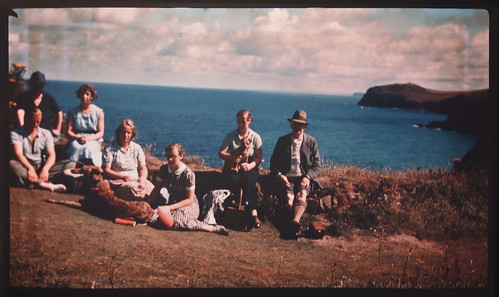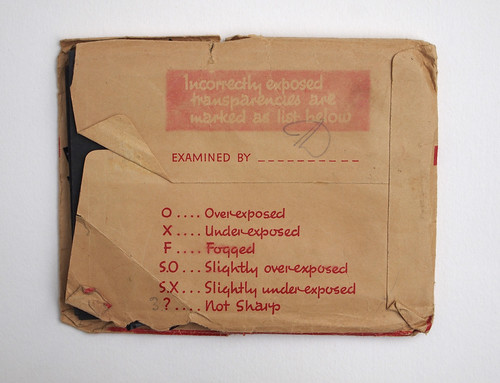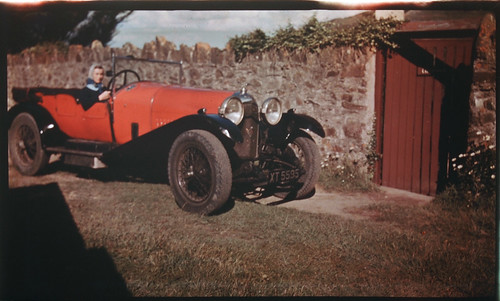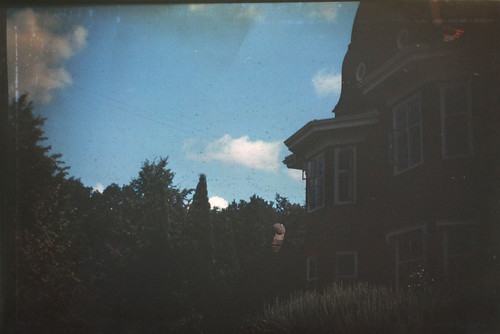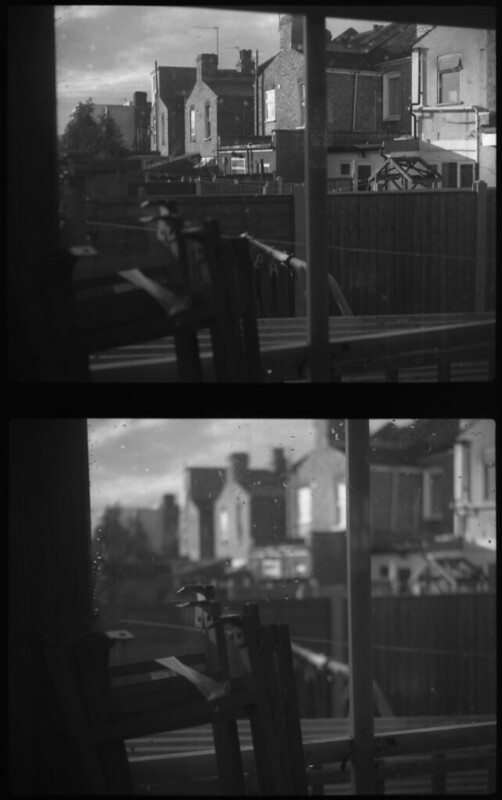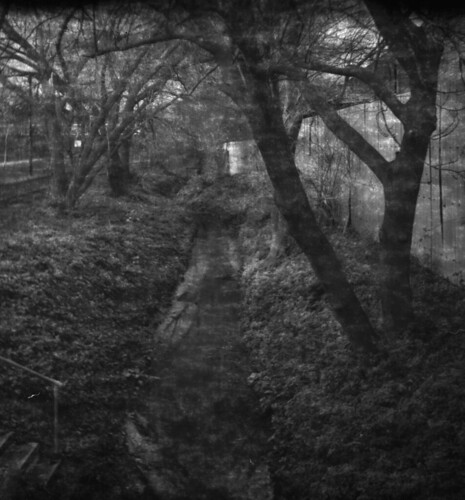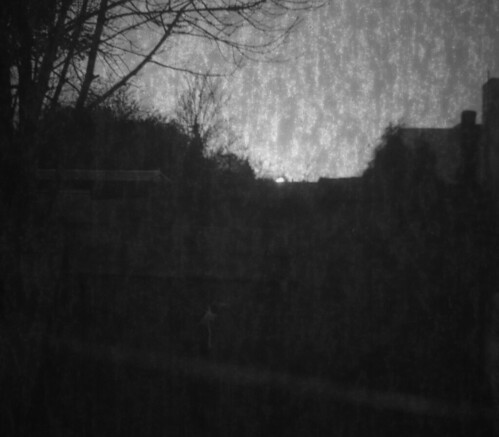"Now, of course, the most important parts of cameras are lenses."
"Ooh no, you can't say that, old boy, you can't say that."
"Why not?"
"That's not grammatical. You should say lends. Lends. I lends, he lends, or he borrows, or he scrounges, that's you. You can't say lendses."
"Yes you can, you don't understand me, the lens, the lens is in front of the camera and it is through this that the light gets to the plate or film."
"Sounds like a little dental outfit, doesn't it?"
Clapham & Dwyer, 'On Photography'
Not to be confused with
Susan Sontag, the above exchange from a 1930s 78rpm record of a variety act works better aloud than being read on the screen, and, in titling this post 'Old Lenses', for some reason, I thought of them. In the post I wrote about the
MPP Micro-Technical camera, I didn't put enough emphasis on one attraction of large format cameras: the ability to use a very great variety of lenses. As long as the lens can actually be mounted on the camera, which in practice means fitting to a lens board, the only considerations as to suitability are, firstly,
bellows draw, whether the bellows can be extended (or retracted) enough to focus the lens and, secondly, the
image circle the lens projects, whether this is wide enough to cover the film format and if it is large enough to also allow movements (a chief attraction in most large format camera designs itself).
When I bought my
MPP Micro-Technical Mk VI camera, it came with a 150mm Schneider Kreuznach f4.5 Xenar lens. On the 4x5 inch format, a 'normal' angle of view, based on the diagonal measurement of the image sizes would be 150mm. However, the angle of view for a normal lens is not directly comparable with a 50mm lens on a 35mm camera (for example), as 4x5 has different, squarer, frame proportions and the 150mm lens sometimes felt a little wide for many shots (I also bought a wide angle 90mm Schneider Kreuznach Angulon lens, although I've rarely used it). Although I've been shooting large format for around four years, it does feel like I still have much to learn (more so than with other formats), and still making mistakes. Considering the options for longer focal length lenses, these can be very expensive, and while it would be ideal to use the best equipment available, an initial outlay of hundred of pounds in lenses that might not be used very often, although an investment, may not be the best way to start shooting large format. Close to the Xenar's 150mm focal length, I found a very cheap (under £40)
f5.3 Zeiss Tessar 16.5cm lens in a dial-set Compur shutter, which I've used for many of the
large format glass plate night shots (I've written elsewhere about my preference for dial-set shutters over the rim-set versions).
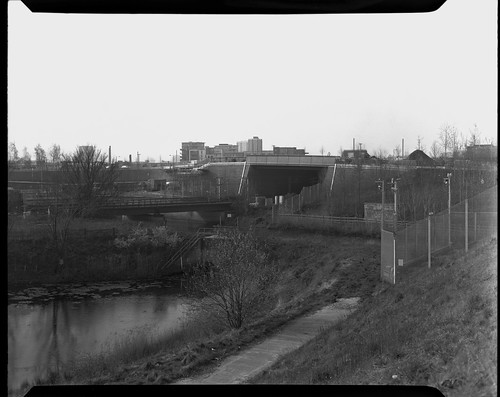 |
| Carl Zeiss Tessar 16.5cm f5.3 lens |
There isn't much to add about the Tessar lens here, except perhaps that it may be slightly lower in contrast to the Xenar due to being a pre-war uncoated lens. This may work better for situations such as in the image above, shot with
Kodagraph Ortho Negative film, a high-contrast repro film (the Xenar, not a recent lens by any means, is
a Tessar-type design, but my lens, from the 1950s, is at least coated, and perhaps better suited to colour work than an uncoated lens). Given the age of the Tessar lens (the serial numbers on the lens and shutter date it to 1926) and the focal length, it possibly came from a camera such as the
Ica Lloyd or
Nixe, a camera using 'postcard' format 122 rollfilm with an optional plate back.
 |
| Bausch & Lomb Rapid Rectilinear lens in Kodak Ball Bearing shutter |
Kodak's 122 format was made for their
No 3A Folding Pocket Kodak. The 122 rollfilm gave negatives of 3¼×5½ inches (8.25x14cm), a sufficient size when most photographic prints were made by contact printing. The No 3A Folding Pocket Kodak was provided with a number of lens/shutter combinations: I had one with a
Bausch & Lomb Rapid Rectilinear lens in a Kodak Ball Bearing shutter, and had intended to convert the camera for (cropped) panoramic shots on medium format film. However, having languished in a drawer for a number of years, I decide to mount the lens and try it with the MPP camera. The Rapid Rectilinear lens design dates back to 1866; this one has a patent date of 'Jan 18 1910' on the shutter. The lens itself doesn't provide very much information: there's no serial number and
no indication of focal length. The apertures are marked in
U.S. stops: 4, 8,
16, 32, 64, 128. These equate to the standard f-stop system of f8, f11, and so on; the U.S. stop of 16
is the same as f16, which is useful to work out how the two systems match up (although U.S. stands for
Universal System, it was not widely adopted, and went out of use around 1920). The ball bearing shutter has speeds of 1/25th, 1/50th, 1/100th and T and
B settings. I tested the shutter speeds by making an audio recording
and found that all speeds were the same, around 1/40th. Mounted on the MPP camera, the focal length of the lens appears to be around 180mm, although this would probably have been expressed in inches originally. As the Rapid Rectilinear lens is made from two sets of cemented symmetrical elements, I'd read somewhere that it should be
convertible: both front and rear sets of lens elements are sufficiently well corrected to form an image alone, and this aspect of the lens I wanted to try for myself.
 |
| Bausch & Lomb Rapid Rectilinear lens with yellow filter |
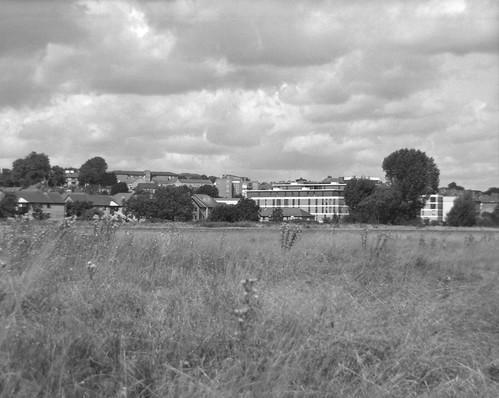 |
| Bausch & Lomb Rapid Rectilinear lens - rear lens elements only |
When shooting with the Rapid Rectilinear, there were a number of calculations to work out the exposures required. To begin with, I used an exposure index of 250 with the Fomapan 400 film and factored in a deep yellow filter for the first of the two images above; the US stops had to be converted; and with only the rear elements in the lower image, I also had to calculate the bellows factor, which I've written about in my last post on
Distars and Proxars.
I also shot the same scene with the
Xenar lens for comparison: the Xenar clearly is much better for edge to edge sharpness, and it is in the out of focus areas where the difference between the two lenses is clearest: the Rapid Rectilinear's characteristics are most noticeable in the long grass in the foreground. In both shots it's possible to discern the
astigmatism in these out-of-focus parts, which the Rapid Rectilinear is not corrected for, especially in the second photograph, which was shot with just the rear lens elements at the widest aperture, which would have been equivalent to f16 at a focal length of around 360mm. This was also shot without the deep yellow filter, which reduces the contrast further. However, the Rapid Rectilinear is still good stopped down and large format is very forgiving at a relatively small scale of reproduction; in a large print it may be a different matter.
 |
| Left: Xenar; right: Rapid Rectilinear (rear elements only) |
The images below, starting with a photograph using the 16.5cm Tessar, were all shot at smaller apertures. These were also shot on Fomapan 400, this time rated 320. I also used the deep yellow filter on the shot without the front lens elements, as the shutter's screw mount protrudes enough for the push-fit filter. With the ball bearing shutter only firing at around 1/40th, by necessity the exposure with just the rear elements of the Rapid Rectilinear was two seconds on the 'T' setting, allowing me to stop the aperture down to the equivalent of f64. As the clouds were moving away from the lens, rather than across the field of view, the length of exposure did not result in blurred clouds, but movement shows up in some of the trees.
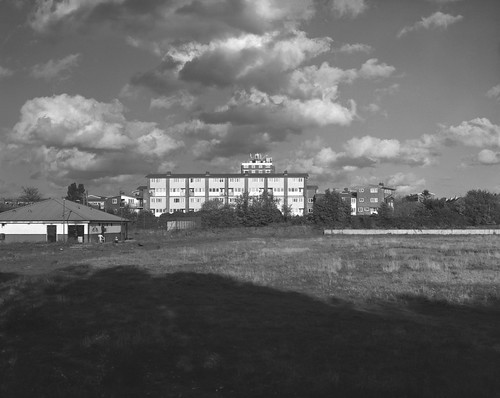 |
| Carl Zeiss Tessar 16.5cm lens with yellow filter |
 |
| Bausch & Lomb Rapid Rectilinear lens with yellow filter |
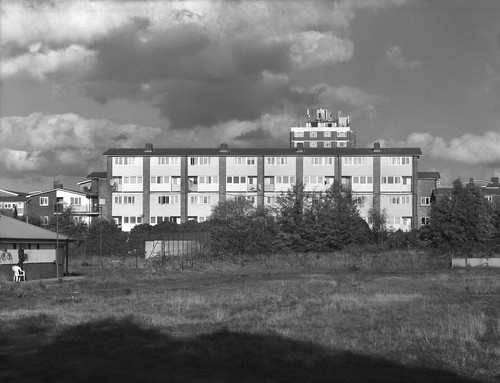 |
| Bausch & Lomb Rapid Rectilinear lens - rear lens elements only with yellow filter |
As the results show, these lenses do have their own character and quirks, and although many better lenses have been designed since the Rapid Rectilinear (and, indeed, the Tessar), and the results will not be as good, older lenses represent a possibility, if also a compromise, of cheaply expanding a range of focal lengths available (especially with convertible lenses) for view and large format cameras.
Sources/further reading:
Through A Vintage Lens on the Rapid Rectilinear
Rapid Rectilinear on Camera-Wiki





